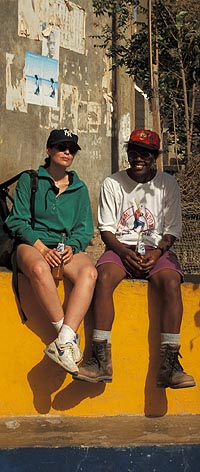|
The Legend tells you what the arrows í mean and how the terms "right" and "left" are used. |
Mindelo
- Areia Branca - Salamansa - Baía das Gatas |
||||||||
List of Tracks |
The old mule track to Salamansa and Baía das Gatas
is more than a short walk. It is a hike because, right at the beginning,
you have to climb a dune of white sand and a pass. Looking back on the
town and Monte
Cara may reward you. Hing passed the fishermen's village of Salamansa,
the track follows the coastline on a dusty path. Starting point is the Market Hall of Ribeirinha [RIBE01]. If you arrive by bus or taxi, you may continue deeper into the quarter of Ribeirinha. The street passes through Ribeirinha ì on the right side* of the Ribeira and becomes a small dustroad where the settlements end. The telefone-line to Salamansa on wooden posts shows the further direction. Where there are the last houses, the path è crosses the dune at its base. Then it climbs ì the left side* over stones an rocks at the rim of the dune. Anyhow, it can not be avoided to walk a few minutes on sand. Downwards from the pass of Branca [AREIA] the path continues to follow the telefone-posts ì to Salamansa. In the lower parts of the village, you have to turn in é directon of the sea, best there where there is the football place [SALA01] . Along the shore, ì the small automatic lighthouse is reached. [SALA02]. Trucks fetching basalt have marked the way to Baía das Gatas [GATAS] along the coast.
|



